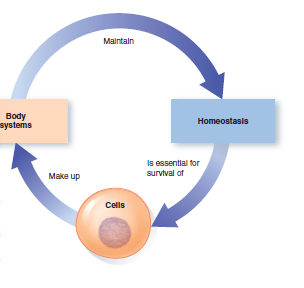
Functional Organization of the Human Body and Control of the “Internal Environment
Organisms are independent living entities.Multicellular organisms, such as trees and humans, are structural and functional aggregates of trillions of cells (multi means “many”). In the simpler multicellular forms of life—for example, a sponge—the cells of the organism are all similar. However, more complex organisms, such as humans, have many kinds of cells, such as muscle cells,nerve cells and gland cells.The basic living unit of the body is the cell. Each organ is an aggregate of many different cells held together by intercellular supporting structures.Each human organism begins when an egg and sperm unite to form a single new cell, which multiplies and forms a growing mass through myriad cell divisions. If cell multiplication were the only process involved in development, all body cells would be essentially identical. However, during development of complex multicellular organisms such as humans, each cell also differentiates, or becomes specialized to carry out a particular function. As a result of cell differentiation, your body is made up of about 200 specialized types of cells. All cells, whether they exist as solitary cells or as part of a multicellular organism, perform certain basic functions essential for their own survival and each cell also performs a specialized function, which is usually a modification or elaboration of a basic cell function.
Body cells can live and function only when the ECF is compatible with their survival; thus, the chemical composition and physical state of this internal environment must be maintained within narrow limits.Maintenance of a relatively stable internal environment is termed homeostasis (homeo means “similar”; stasis means “to stand or stay”). The functions performed by each body system contribute to homeostasis, thereby maintaining within the body the environment required for the survival and function of all cells. Cells, in turn, make up body systems. This is the central theme of physiology. Homeostasis is essential for the survival of each cell, and each cell, through its specialized activities as part of a body system, helps maintain the internal environment shared by all cells.
At the end of this lesson, students will be able to understan;
EXTRACELLULAR FLUID—THE “INTERNAL ENVIRONMENT”
LEVELS OF ORGANIZATION IN HUMAN BODY
HOMEOSTASIS—MAINTENANCE OF A NEARLY CONSTANT INTERNAL ENVIRONMENT
HOMEOSTATIC CONTROL SYSTEMS


